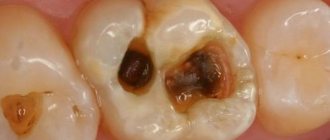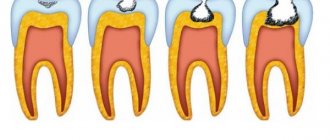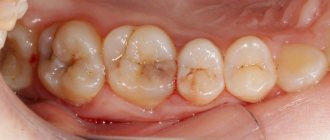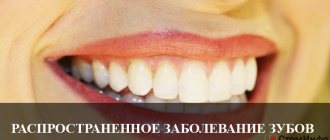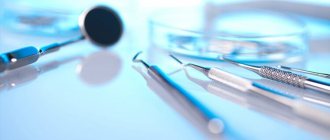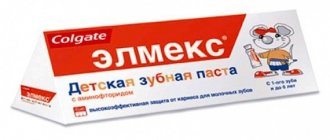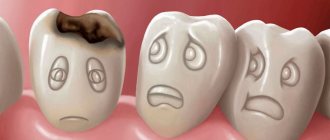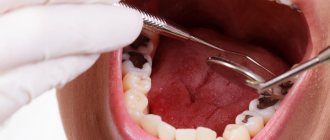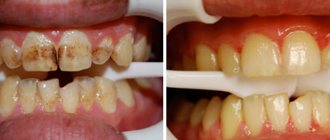Caries - causes (etiology)
Despite the lack of etiological, morphological and clinical similarity of the processes and any other justification, this term was used to describe a disease of the hard tissues of the tooth, the external manifestation of which is the destruction of enamel and dentin. Since factors of the internal environment are of a certain importance in the occurrence and course of the carious process in a tooth, most authors consider the carious process as a manifestation of a general disease of the body with external signs in the form of damage to dental tissues. D. A. Entin’s proposal to consider dental caries as a carious disease received wide support. The causes of caries have been the subject of the work of many generations of dentists. In our country, leading dentists I.G. worked on the problem of caries. Lukomsky, D.A Entin, E.E. Platonov, V.K. Leontiev et al.
There are more than 400 theories about the occurrence of dental caries. One of the latest concepts comes down to the fact that as a result of non-compliance with oral hygiene (insufficient regular and proper care and brushing of teeth), soft plaque appears where chewing does not remove this plaque (lateral surfaces of teeth, fissures of chewing surfaces) and is firmly associated with surface of the teeth. Plaque, consisting mainly of polysaccharides, serves as a concentration site for a variety of bacteria and fungi. The inclusion of mineral salts in plaque promotes its compaction, it becomes hard and difficult to separate from the tooth. In practice, such a formation is called dental plaque (50% of the bacteria that make up the plaque are streptococci). Bacteria produce lactic acid, which can cause demineralization of the enamel, which begins the carious process. The matrix of soft dental plaque consists of polysaccharides, proteins and lipids (in smaller quantities). A prominent place in the structure of plaque is given to dextran polysaccharide, produced by plaque bacteria. Streptococci produce dextran from sucrose. Apparently, this is why consuming large amounts of sugar contributes to the occurrence of caries.
Additional causes of caries -
We have already said above that in addition to the main factors (dental plaque and food debris), there are also causes in the oral cavity that predispose to the appearance of caries. These include:
The presence of crowded teeth (Fig. 6) – this contributes to food getting stuck between the teeth, and also complicates the process of oral hygiene. Therefore, such patients almost always experience rapid formation of dental plaque, gum inflammation, and dental caries.
Low rate and amount of saliva secretion - salivation helps to some extent to wash away food debris from the teeth after eating. So per day, normally about one and a half to two liters of saliva should be produced. If a person’s salivation is low, then this is a prerequisite for faster development of caries.
Neutral indicator of saliva acidity – saliva has an alkaline environment, which is determined by its buffer capacity. Therefore, it can to some extent neutralize organic acids produced by cariogenic bacteria. However, if a person has a low buffering capacity of saliva, it will have a neutral pH and, accordingly, will no longer be able to neutralize organic acids that dissolve enamel.
Dietary disorder – one of the decisive factors is the frequency of consumption of carbohydrates (sucrose, glucose, fructose, lactose and starch). Therefore, periodic snacks between main meals in the form of cookies, sweets, buns, etc. (provided there is no subsequent immediate brushing of teeth) – leads to the development of caries.
Caries – mechanism of occurrence (pathogenesis)
The effect of cariogenic bacteria contained in dental plaque does not manifest itself in the same way in every person. Some people (unfortunately, the majority) have low resistance to caries, while others have a fairly high resistance. There is hardly any doubt that the resistance of teeth to caries is associated with the natural defense and resistance of the body. In people with weakened resistance, soft plaque forms more actively.
It is believed that the frequency of carious lesions is determined not only by the state of the body, but also by the composition and properties of saliva. Thus, in persons susceptible to caries, saliva is more viscous, and the content of mineral salts in it changes. Thus, according to the described theory, the occurrence of caries is associated with the action of microorganisms, the reproduction activity of which in the oral cavity depends on the natural resistance of the body.
However, despite its harmony and frequent confirmation by practice, this theory does not explain many of the causes of caries and the factors determining its absence. Thus, often in practically healthy people, without any disturbances in the body, a large amount of dental caries is detected. At the same time, in chronically ill patients with disorders of a number of basic body functions, including metabolism, caries is absent or limited. The described theory cannot yet explain such observations.
At the same time, systematic preventive examinations of children carried out in Russia have revealed a close relationship between the general condition of the child and the degree of carious lesions. Thus, in children suffering from tuberculosis, rickets, and exudative diathesis, dental caries damage increases by 1.5–2 times. In children who survived the siege of Leningrad during the Great Patriotic War, after its end, dental caries was observed 2 times more often than in children taken out of the city before the siege. Undoubtedly, these data indicate the significant importance of the nutritional factor for the onset of the carious process.
It should be assumed that the use of modern achievements of science and technology (electron microscopy, histochemistry, etc.) will finally reveal the full variety of causes of such a common disease as dental caries. Thus, in recent years, as a result of the use of advanced and highly sensitive techniques, it has been possible to objectively confirm the active role of all body functions in the pathogenesis of dental caries. In addition, a violation of mineral metabolism in the early period of dental caries has been proven. It is very important that the development of caries begins with a breakdown of the connection between the mineral and protein components of the enamel.
Recent studies have shown that dental caries occurs under the influence of a complex of both general and local influences. It has been proven that in the occurrence of caries, in addition to dental plaques, enamel permeability and the presence of carbohydrates in saliva play a certain role. The resistance of a tooth to caries is, of course, influenced by past diseases.
To prevent dental caries, it is recommended to administer fluoride and calcium salts (locally and orally) in order to increase the structural resistance of the enamel.
Theories of caries
We cannot agree with the opinion existing in the dental literature that there are a hundred theories of the etiology of caries. There have been many attempts to uncover the etiology of caries, but this does not mean that each of these attempts can represent an independent theory of caries. For example, Keyes published the work “The Significance of a Kiss in the Occurrence of Dental Caries,” in which it was experimentally proven that caries is a transmissible disease that can be transmitted from one animal to another through contact. The author assumed that the same is true for human caries. How important is this work? It complements those obtained by Orland et al. evidence that caries does not exist without microorganisms. The author himself did not call his work “caries theory.”
The theory of caries should provide for a comprehensive study of the possible causes (causes) and factors of the occurrence of the pathological process and their reliable argumentation, as well as indicate real ways to prevent and treat the disease. Currently, there are not many theories that meet such requirements: these are the theory of D. A. Entin, I. G. Lukomsky, A. E. Sharpenak, the working concept of the etiology of caries by A. I. Rybakov and the foreign theories of caries by Miller and Schatz - Martina.
The concept of counter-influences on the dental pulp . The concept of A.I. Rybakov was based on the potential possibility of developing the carious process at different periods of the body’s life (Table 7). Proof of this is the greatest intensity of caries development during periods of age-related physiological changes in the internal organs and systems of the body, as well as the influence of external and internal factors on the formation and vital activity of the dentofacial apparatus. External and internal cariogenic factors can create conditions in the body for the occurrence of a pathological process only with a certain interaction between them and in the presence of a pathological situation. In this situation, trigger mechanisms are also needed, which can be both exogenous and endogenous factors. One of several and many factors in the triggering mechanism are dominant.
The entire existence of the human body, including the prenatal period of development, A. I. Rybakov divided into several periods, or phases, which had their own specific cariogenic factors that predispose dental tissue to the development of a pathological process in the future, as well as specific dominants in different periods of life that can serve as a trigger for caries in a cariogenic situation.
The formation of dental tissue begins from the 5th week of the intrauterine period of human development. During this period, a factor predisposing to the development of caries may be the code of genetic information. Of the exogenous factors, the most important are the mother’s illnesses, her nutrition, deficiency of microelements in drinking water and food, primarily fluorine and magnesium, and the introduction of certain medications into the mother’s body. From the 12th week of intrauterine development, the second period begins, which is characterized by the formation of internal organs and body systems. Disturbances in the formation of organs and dysfunctions in the fetus can negatively affect the development of the tissues of the primordia of baby teeth. Subsequently, this circumstance turns into a factor in reducing tooth caries resistance. In the third period of embryogenesis (from 5 months), the formation of the rudiments of permanent teeth occurs. The degree of their usefulness may be affected by the mother’s illnesses and her poor nutrition.
The nature of the course of the entire period of ontogenesis is influenced by the climatic and geographical features of the area where the mother lives: climate, composition of drinking water, specific nutrition, epidemiological situation of the area.
After birth, several phases are observed in the development and functioning of the body, characterized by certain physiological characteristics: the period of childhood, 12-14 years, 14-17 years, 17-20 years, 20-40 years and over 40 years. For example, during childhood (from 6 months to 6 years), illnesses of the child and some exogenous factors (poor hygienic condition of the oral cavity, malocclusion, trauma to the dental system) can serve as a predisposing background for the development of caries.
In the period from 20 to 40 years, the body often has common diseases. All patients with dental caries at this age have simultaneous damage to the gastrointestinal tract or liver or a disease of the endocrine system. At the age of over 40 years, there is a deficiency of some body functions, a decrease in the activity of the gonads, stress reactions are more pronounced, hidden insufficiency of the insular apparatus occurs, the functional activity of the adrenal cortex and thyroid gland increases, and the body’s resistance to external influences decreases. All these factors predispose to the occurrence of dental caries.
With a simultaneous traumatic effect on the tissues of the teeth, dental disease that has arisen, the appearance of soft plaque on the teeth and their depulpation, dental caries can occur. In this case, trauma, unhygienic maintenance of the oral cavity, microorganisms, and nutritional disorders will be dominant.
However, the carious process occurs only if there is an interaction between endogenous and exogenous factors in the body. When the tissue structure is inferior, resulting from a violation of the formation of teeth in the prenatal period, in the case of a predominance of external cariogenic causes in the trigger mechanism, single dental caries lesions occur. Multiple caries develops with a predominance of internal factors and, first of all, with dysfunction of the liver and insular apparatus.
Thus, A.I. Rybakov considers the pathogenesis of caries as a process of counter-influences on the dental pulp, i.e., he interprets the mechanism of the pathological process from a polyetiological position. Evidence of this is provided by experimental and clinical observations, according to which changes in the pulp were found in patients with caries under both endogenous and exogenous influences. However, A.I. Rybakov’s concept does not contain specific indications of the mechanism of initial damage, i.e., the characteristics of those processes that occur in the dental tissues.
Neurotrophic theory of caries . D. A. Entin developed a diagram of the pathogenesis of dental caries (Fig. 19), which was supplemented. In accordance with the additions, caries disease, leading to tooth decay, is the result of human conditions associated mainly with the influence of environmental factors and, consequently, with the state of the central nervous system and its highest part - the cerebral cortex, which is located in functional relationship with numerous centers of the subcortical region.
According to D. A. Entin, under certain unfavorable conditions (poor nutrition, emotional factors, etc.), the functional state of the central nervous system is disrupted and conditions are created for the appearance of pathological reflexes, which lead to disruption of trophic processes in the hard tissues of the tooth and destruction of the latter . Based on literature data and his own research, the author believed that normal corticodental relationships, expressed in the adequacy of the physiological reflex reactions of the tooth to certain irritations, determine the normal nutrition and trophism of the hard tissues of the teeth, i.e. they create a dynamic balance between the pulp and hard tissues teeth and between the latter and saliva as the immediate external environment of the tooth.
The reactions of the pulp to physiological reflex influences are physical and chemical processes that are manifested by centrifugal osmotic and capillary currents in the tooth tissues and the predominance of the synthetic function of enamel phosphate over the disintegrating one. The reactions of the pulp to pathological reflex influences are those physicochemical processes that are expressed in centripetal osmotic and capillary currents in the tooth tissues and the predominance of the breaking down function of enamel fasphatases over the synthetic one. This concept is called the neurotrophic theory of caries.
To experimentally prove his theory, the author undertook experiments on dogs to which chronic irritation was applied to the area of the gray tubercle according to Speransky’s method. In 13 out of 43 animals, pathological changes occurred in the internal organs and oral cavity, and dystrophic disorders were discovered in the form of fragility, abrasion, spotting, erosion and necrosis of tooth enamel. However, it is known that D. A. Entin was unable to obtain dental caries in dogs against the background of trophic lesions of a number of organs in experimental animals.
Trophic theory of caries by I. G. Lukomsky . I. G. Lukomsky (1948) believed that the mechanism of caries development lies in the disruption of the trophic function of odontoblasts, the trophism of which, in turn, is disrupted under the influence of many, mainly endogenous, reasons, including changes in the state of the nervous system (Scheme 2).
The author confirmed this scheme with experimental observations, which, in his opinion, revealed the trophic connection of odontoblasts with enamel, as well as teeth and odontoblasts with the center of the trigeminal nerve. The experiments consisted of mechanical damage to the odontoblasts of the animal's tooth germ, as a result of which the process of enamel calcification was disrupted and inhibited. This fact, according to the author, convincingly illustrates the relationship between the function of odontoblasts and the process of deposition of lime salts in the enamel. Based on the described experiments, as well as experiments with damage to the central branches of the trigeminal nerve, the author concluded that odontoblaetes, in addition to the dentinogenic one, also have a trophic function in relation to the hard tissues of the tooth, i.e. dentin and enamel.
The essence of I. G. Lukomsky’s experiments was to search for evidence of the mechanism of transmission of pathological impulses from damaged or irritated odontoblasts to the tooth enamel, where the carious process directly begins. In our opinion, the arguments given by the author are most often of a declarative nature, and most of his experimental evidence of the vitality of enamel and the trophic connection of odontoblasts with tooth enamel has been revised and clarified. It is now known that enamel in vivo is a permeable tissue, that ion precipitation occurs in it, and the carious process begins with demineralization with the participation of microorganisms. The contribution of I. G. Lukomsky to the study of the problem of dental caries is the data that there is a relationship between the pulp and hard tissues of teeth, which is clearly visible during the formation of tooth tissues and is less pronounced after its eruption.
Chelation theory of caries . Without going into details of assessing the general condition of the body, the creators and supporters of this theory argued that caries begins as a result of chelation, or complexation, of the enamel skeleton with chelates, or complexing agents of the oral fluid.
Martin, Isenberg, Trelawny and Schatz in 1954 substantiated the chelation process with the idea that enamel does not consist of two independent systems - mineral and organic, but is an integral structure consisting of chelates or complexes with coordinated covalent bonds connecting organic and inorganic Components. Carious destruction of enamel, according to the authors, occurs as a result of simultaneous processes of proteolysis and chelation or detachment of mineral-organic complexes.
There are many substances in the oral fluid, in particular enzymes and other protein substances that can form soluble chelates with calcium. Chelates can also be of food or bacterial origin. Some of these chelating agents are active at neutral pH. The authors give examples of chelation: the use of ethylenediaminetetraacetic acid (EDTA) for demineralization of bones and teeth; the effect of citrate in blood preservation, which eliminates ionic calcium. Schatz et al. proposed to direct research to the search for keratinolytic microorganisms in the carious lesion, considering them to be the cause of caries.
Caries theory Schatz, Martin et al. lacks experimental and clinical evidence. However, in a theoretical aspect, it can be used, since discussions are still ongoing on the question of the ultradynamics of disintegration of hard dental tissues: what is affected or what is lost primarily (organic or mineral matter or both) at the beginning of a carious lesion. Proteolysis and chelation of enamel are theoretically possible, and no one has yet been able to refute this, although the primacy of damage to the mineral substance of the hard tissues of teeth is considered proven.
Back in 1906, Bodeicker and in 1921, Gottlieb showed on histological preparations that the enamel contains plates, or lamellae, containing organic material that can dissolve, contributing to the rapid spread of caries. Somewhat later, Gottlieb et al. (1946) expanded these studies and came to the conclusion that the initial carious lesion occurs due to the effect of proteolytic enzymes that destroy the lamellae, organic prism membranes and enamel bundles. With active caries, they considered it obligatory to have a yellow pigmentation of the lesion, which indicates the penetration of organisms into it that cause this pigmentation. The formation of a carious cavity, according to the authors, occurs due to proteolysis, although a certain amount of acid can also form in the carious lesion.
In in vitro experiments, McClure and Kuzicka (1946) demonstrated tooth demineralization in a medium containing citrates. The process took place at pH from 5.5 to 7.2 with the formation of a soluble calcium-citrate complex.
Frisbie et al. (1947) on histological preparations of intact and carious enamel discovered microorganisms in the lamellae, as well as changes in the organic matrix of the tooth in certain areas under dental plaque, on the basis of which they assumed that the carious process is proteolysis of the organic fraction of enamel by extracellular enzymes. Somewhat later, the authors established that caries initially affects the organic enamel matrix, and then the penetration of microorganisms into the tooth tissue occurs. At the next stage, a decrease in mineral salts is observed due to the action of acids formed during the decomposition of organic matter (Frisbie, 1950).
Pincus (1949) discovered mucoprotein sulfate in the organic fraction of enamel, and chondroitin sulfate in dentin, which may contain sulfuric acid. As a result of the enzymatic activity of gram-negative bacteria, sulfatase is produced, which damages the proteins of enamel and dentin, hydrolyzes them, releasing the polysaccharide complex of proteins, and subsequently sulfuric acid, which ensures further disintegration of the enamel. According to Gottlieb (1944), proteolytic enzymes dissolved lamellae, organic prism shells and enamel bundles consisting of organic components.
However, without finding specific histological evidence of proteolysis and chelation, some authors made a compromise solution, allowing both proteolysis-chelation and demineralization combined. Hardwick and Manly (1952), using methods of combined physicochemical and histological research, obtained data according to which carious lesions can be of two types. In the first type, the enamel is invaded by microorganisms, penetrating through the lamellae into the dentin and, even before clinical signs of damage, causing true proteolysis. In the second type, acidic dissolution of the enamel is observed (usually in the form of chalky spots).
None of the proteolytic theories of caries mentioned above described the beginning of the process. It is not clear why enamel proteins, or rather individual areas of the tooth crown, undergo dissolution. Later, this issue attracted the attention of proteolytic theories. Thus, Morch et al. (1969) indicated that the onset of a carious attack is ensured by the intake of carbohydrates, which provide the effect of complexing agents (chelates) present in the oral fluid during the neutral pH phase.
Morch et al. (1971), taking into account this issue in vitro using the method of radioactive isotopes on 88 freshly extracted human teeth, showed that during the period of enamel destruction, both sodium salts of amino acids (chelates) and lactic acid (or other acids) are capable of decalcifying the enamel (according to the indications of inclusion of 32P ). Given the above, the authors assumed that decalcification and chelation occur when carbohydrates are consumed. The onset of these processes is the combined effect of acidic dissolution of apatite at low pH and chelation under the condition of neutral pH of dental plaque. Many components of oral fluid can take part in the destruction of enamel protein. These data and the reports of other authors are closest to the truth, i.e., experimental evidence has been obtained for the possibility of rhoteolysis and chelation of hard dental tissues. However, studies conducted in vitro, even under conditions close to those of the oral cavity, do not allow the conclusions drawn to be considered definitive.
The theory of caries by A. E. Sharpenak (1949) compares favorably with the theory of his followers (Schatz, Martin, 1954), since it takes into account metabolic disorders of the body during a cariogenic diet and, most importantly, proposes methods for the treatment and prevention of caries. Unfortunately, the data from the author's experimental and morphological studies were not further developed: they noted a number of methodological errors.
N.I. Trunilina (1972) studied metabolic disorders in rats when they were kept on cariogenic diet No. 17, but she was unable to confirm the main provisions of A.E. Sharpenak’s theory of caries. Clinical work on the prevention of caries through the introduction of protein and vitamin supplements into the food of schoolchildren has also not received sufficient confirmation.
Widely known studies by Darling (1959) do not support proteolysis - the chelation theory of caries. The author, studying early carious lesions of the enamel using microradiography and polarized microscopy, found that in all cases the focus of the carious lesion appears below the intact surface of the enamel. In his opinion, this fact indicates the primacy of demineralization, which occurred before any histological changes in the organic matter of the enamel.
A large amount of organic matter was found in carious enamel. According to Johansen (1965), this does not confirm the assumption that the carious process begins with proteolysis. Consequently, the destruction of the matrix is a late stage, a consequence of caries. Damage to dentin collagen, according to the author, is the final stage - the result of its destruction.
Histological research methods also do not detect proteolysis products of carious lesions. E.V. Borovsky (1967), Miller and Massler (1963) did not find qualitative differences in the amino acid composition of carious and healthy enamel during biochemical analyses. Soluble and insoluble proteins do not differ in the set of amino acids.
There are data that in a certain way weaken the main condition on which the proteolytic and chelating theories are based - the possibility of acquisition at a neutral pH. Brosowsky (1966), studying the effect of organic and mineral acids on tooth matter at different pH values, discovered that some organic acids, neutralized to pH 6.9, can dissolve and elute calcium from apatites. Thus, the course of a carious lesion even at a neutral pH does not mean that demineralization is excluded from this process.
Acidogenic and chemical-parasitic theories of caries were proposed 80-100 years ago and are the most ancient of all theories of caries, if not with
Caries - pathological anatomy
Caries is characterized by 3 zones, which are revealed when examining a tooth section under a light microscope:
- zone of decay and demineralization;
- zone of transparent and intact dentin;
- zone of replacement dentin and changes in the dental pulp.
In the first zone there are remains of destroyed dentin and enamel with a large number of microorganisms. The dentinal tubules are dilated and filled with bacteria. Dentinal processes of odontoblasts in a state of fatty degeneration. Softening and destruction of dentin occurs more intensely along the enamel-dentin junction, which is clinically determined by the overhanging edges of the enamel, a small entrance hole into the carious cavity. Under the action of enzymes secreted by microorganisms, the organic matter of demineralized dentin is dissolved.
In the second zone there is destruction of the dentinal processes of odontoblasts; there is a huge number of microorganisms and decay products. Under the action of enzymes secreted by microorganisms, the organic matter of demineralized dentin is dissolved. Along the periphery of the carious cavity, dentinal tubules expand and become deformed. Deeper is a layer of compacted transparent dentin - a zone of hypermineralization, in which the dentinal tubules are significantly narrowed and gradually transform into a layer of intact (unchanged) dentin.
In the third zone, a layer of replacement dentin is formed, containing less oriented dentinal tubules.
Chemical-parasitic theory (Miller, 1884)
Miller pointed out some predisposing factors that contributed to the development of caries, namely:
- Heredity
- Nutritional nature
- Properties of saliva
Miller identified two stages in the development of caries:
- The first stage is the demineralization of tooth tissue due to the dissolution of inorganic enamel substances by acids, into which carbohydrate foods break down.
- The second stage is the destruction of the organic dentin matrix by enzymes secreted by bacteria.
Caries - symptoms (clinical picture)
Depending on the clinical manifestations of the carious process, 4 forms of caries are identified, each of which essentially reflects the degree of damage to the hard tissues of the tooth. A carious spot (macula cagiosa), superficial caries (caries superficialis) define a carious process that affects only the enamel; medium caries (caries media) characterizes the spread of the process to the enamel and the peripheral part of dentin; deep caries (caries profunda) corresponds to the carious process developing in the deep layers of dentin. Deep caries without appropriate treatment can be complicated by inflammation of the dental pulp and pulpitis.
The initial sign of caries is the appearance of a whitish (chalky) spot, which is an area of enamel clouding with weaker light refraction. In this case, no signs of destruction of the enamel surface are observed; upon probing in the area of the chalk spot, no enamel defect is detected. Its surface remains smooth, the probe does not linger when sliding.
Sometimes, under the influence of reasons that have not yet been clarified, the chalk stain disappears and the progression of caries stops. This reverse development of the pathological process in the enamel indicates the significant role of the endogenous factor in the pathogenesis of dental caries. However, the most likely outcome of the chalk spot stage is brown pigmentation of the enamel lesion. Following the stage of pigmentation, roughness appears on the affected area of the enamel. In addition to roughness, a dental probe can determine areas of softening of the enamel. Once a tissue defect in the enamel appears, the process cannot be reversed. The stage of superficial caries ends with the spread of the carious lesion over the entire thickness of the enamel. If the carious cavity is located in the dentin layer at a shallow depth, we speak of medium caries. Deep caries means a carious cavity, the bottom of which is a thin layer of dentin, separating this cavity from the dental chamber. The clinical manifestations of caries are very clear: the absence of spontaneous pain and episodic pain attacks caused by thermal (cold water, cold air, etc.) and chemical (sour, salty, sweet foods) factors.
Soon after eliminating these irritants, the pain disappears. With deep caries, pain may appear due to mechanical pressure on the thinned bottom of the carious cavity of food entering the carious cavity during chewing. Removing food debris from the cavity usually relieves pain.
Despite the relatively conventional division of caries into medium and deep, the determination of these stages is essential for the diagnosis and treatment of affected teeth. With deep caries, inflammation of the pulp is a very possible complication.
Symptoms of caries
Caries will not be long in coming in the following cases: if you pay little attention to daily dental hygiene; with reduced immunity, for example, due to a long-term cold; if you eat a lot of fast carbohydrates.
Carious bacteria and the acid they secrete are very insidious - in the initial stages, caries is practically asymptomatic. That is why it is so important to regularly attend preventive examinations, during which the dentist has the opportunity to diagnose caries in the initial stages.
Caries - treatment
The affected areas of enamel and dentin are removed by mechanical treatment of the cavity using a bur and drill. As a result, the cavity formed in the hard tissues of the tooth is naturally larger than the carious defect. After medical treatment to restore the anatomical shape and physiological function of the tooth, the cavity is filled with filling material.
The treatment of moderate and deep caries should be approached differentially.
Treatment of superficial and medium caries is carried out in one session, and deep caries in 2-3 sessions, since it is necessary to exclude the possibility of developing pulpitis. On the first visit to a patient with deep caries after treatment, the cavity is closed with a temporary (control) filling. After the control period has expired (7–10 days), in the absence of caries complications (acute pulpitis), final treatment is carried out with the application of a permanent filling. Experienced doctors, using electroodontodiagnosis to monitor the condition of the pulp, treat deep caries in one session.
If the stages of treatment are carried out correctly and in the absence of caries complications, all functions of the affected tooth are restored.
Caries - prevention
Sanitation of the oral cavity should be systematic, especially in children and adolescents, as well as in military personnel, pregnant women and workers dealing with occupational hazards.
Sanitation of the oral cavity consists of healing affected teeth and removing those that are not amenable to conservative treatment and are chronic foci of infection.
Due to the fact that pain during dental caries may be absent for a long time or not appear at all until the development of acute pulpitis, many people do not pay attention to the occurrence of the carious process. This often leads to significant destruction of the crown part of the tooth, the occurrence of complications of caries (pulpitis, periodontitis), which not only complicates treatment, but sometimes casts doubt on the possibility of saving the affected tooth.
During planned sanitation, usually carried out 2 times a year, carious teeth are identified and treated, and the normal chewing function of the dental system is restored and maintained.
Planned sanitation of the oral cavity in children is of exceptional importance. Timely treatment of baby teeth and their preservation until natural replacement ensures normal chewing, which is a physiological stimulator of jaw growth and reduces the possibility of improper eruption of permanent teeth.
Planned sanitation of the oral cavity is also indicated for patients with chronic diseases. Such diseases primarily include rheumatic carditis, nephritis, polyarthritis, etc. The entry of toxins from a newly emerging source of infection in the tooth can cause an exacerbation of the underlying process and aggravate the course of the disease.
In patients with a chronic form of rheumatism, after sanitation of the oral cavity, the general condition improves, the number of exacerbations of the general disease sharply decreases, and the number of days of temporary disability is greatly reduced.
Planned sanitation of the oral cavity is of great preventive importance in preventing diseases of the gastrointestinal tract, especially the stomach. Rough food, insufficiently crushed by diseased and decayed teeth, negatively affects the gastric mucosa, causing its inflammation. Food well crushed in the oral cavity does not injure the gastric mucosa. Treatment of gastritis and gastric ulcers begins with restoring the chewing efficiency of the dental system. This is achieved not only by removing teeth that cannot be treated, but also by using dentures to restore chewing function lost as a result of tooth extraction.
Caries - prevention of damage to hard dental tissues in workers of a number of enterprises
This prevention is of particular importance for workers in the chemical industry who have to deal with acids. Vapors of inorganic acids (nitric, sulfuric and hydrochloric, or hydrochloric) destroy enamel and dentin as a result of the dissolution of calcium, phosphorus, and fluorine salts that make up the hard tissues of teeth. Unlike the carious process, with this type of destruction of enamel and dentin there is no carious cavity.
Acid necrosis most often affects the anterior teeth and spreads diffusely over the tooth surface.
As a result, a shortening of the tooth crown and an increase in interdental spaces occur, caused by the melting of the inorganic skeleton, first of the enamel, and then of the dentin. Subsequently, the shape and size of the crown part of the tooth changes. In advanced cases, acid necrosis of the dental pulp develops. Complete tooth destruction takes different times depending on the frequency of exposure and concentration of the chemical irritant, as well as on the individual strength of dental tissues.
Similar damage to the hard tissues of teeth is possible among workers at enterprises that produce alkali and glass, as well as among those employed in mining.
The basis of preventive measures should be improvement of production conditions, individual precautions, consisting of periodic rinsing of the mouth with a 1-3% solution of sodium bicarbonate (soda), 1% solution of borax during the working day.
Similar preventive measures should be carried out in chemical plants where alkalis are produced. Workers in such industries need to rinse their mouths repeatedly throughout the working day with a 0.5% boric acid solution.
Caries - prevention of caries in children
Sanitation of the oral cavity also includes measures aimed at preventing caries. This is the creation of conditions that increase the resistance and resistance of hard tooth tissues to the carious process.
As is known, the formation of baby teeth occurs in the prenatal period. A lack of calcium, phosphorus and other mineral salts in the mother’s body can negatively affect the strength of the child’s dental tissues. In this regard, the food of pregnant women should contain a sufficient amount of mineral salts and vitamins. Rational nutrition is also necessary during breastfeeding to ensure that a sufficient amount of necessary substances enters the growing body. In addition to a balanced diet, a child needs vitamins C and D. Experiments on animals have shown that a lack of these vitamins in the body leads to the development of multiple dental caries.
A certain importance in increasing the resistance of enamel to caries is the normal chewing load on the teeth, which ensures the maintenance of the physiological functions of the masticatory apparatus and improves the blood supply to the periodontium and pulp. Children should not be protected from active chewing.
On the contrary, children should be given raw vegetables, fruits and other foods that require significant effort to chew.
Local factors influencing the development of caries
Local factors are mainly the condition of the patient’s oral cavity at the time when caries has already begun to develop, or he simply fell into a risk group (for example, he had an infectious disease, received radiation exposure, or was forced to work at a chemical plant). These include:
- poor oral hygiene. You need to brush your teeth at least twice a day - this immutable rule of dental care is worth repeating once again. But even its strict adherence will not fully protect against caries. Be sure to clean hard-to-reach places using dental floss and mouthwash. And once a year, contact your dentist for professional cleaning and tartar removal;
- presence of braces or dentures in the mouth. Such devices contribute to the deposition of plaque and the growth of bacteria, while at the same time making oral care more difficult;
- abuse of sweets, which creates an excellent environment for the growth of microorganisms;
- scanty salivation. Typically, saliva serves as a natural defense against caries, as it washes away the resulting plaque and contains alkalis that neutralize pathogenic microorganisms. If there is not enough of it, it is too thick, this does not happen. In addition, the altered composition of saliva can also contribute to the oxidation of tooth enamel - after taking antibiotics, for example.
We can summarize: for caries to develop, at least two or more factors, general and local, must coincide. For example, a person lives in an area with poor ecology, works in a convenience store, due to which he constantly experiences stress, eats irregularly, mostly processed foods and does not get enough sleep, and often forgets to brush his teeth before bed due to fatigue. All conditions for caries have been created, especially if, on top of that, the digestive or cardiovascular systems fail.
In dentistry, all people are conventionally divided into two groups: caries-resistant, that is, resistant to this disease, and caries-susceptible. But even if you belong to the latter, this does not mean that by the age of 30 all your teeth should inevitably be covered with black spots and cavities. With proper care, good nutrition and respect for one's health, even a person at risk can have strong and healthy teeth into old age.
It is important to know:

